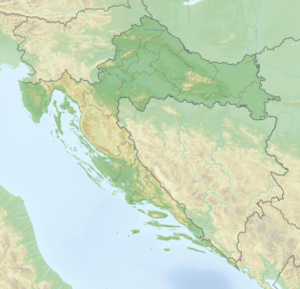Tržan Castle
| Tržan Castle | ||
|---|---|---|
|
Tržan Castle ruins today |
||
| Alternative name (s): | Modruš Castle | |
| Creation time : | 9th century | |
| Castle type : | Höhenburg, ridge position | |
| Conservation status: | ruin | |
| Standing position : | Nobles | |
| Construction: | Ashlar | |
| Place: | Modruš , Croatia | |
| Geographical location | 45 ° 7 '40.8 " N , 15 ° 14' 27.6" E | |
|
|
||
The Tržan [ trʒan ] or Tržan-grad castle is the ruin of a ridge castle in the central Croatian town of Modruš . It is located in the northern part of the historical Lika region , today in the territory of the Josipdol municipality in the Karlovac County , on a 670 meter high ridge above Modruš, on the eastern slopes of the Velika Kapela Mountains, through which since ancient times led an important trade route that connected the continental inland with Senj on the Adriatic coast .
history
According to historical sources and according to the opinion of the well-known Croatian historian Vjekoslav Klaić (1849-1928) there was a kind of fortress above the Modruš settlement as early as the beginning of the 9th century, during the fierce fighting there between two rival ruling princes of two Croatian states at that time, coastal country - and Pannonian Principality of Croatia , Borna and Ljudevit of Posavia .
The almost ideal dominant strategic position made it possible that the castle was never conquered by anyone, although the city of Modruš below the castle was stormed, looted and burned by the Ottomans in 1493, just before the battle on the Krbava field .
Since the 11th century the seat of the Modruš County (later Modruš-Rijeka County ), the castle has been in the possession of the Princes of Krk (later, from around 1430, known as Frankopans ), as the Hungarian-Croatian King Bela, from 1193 II. (III.) Gave it to Prince Bartol II. Krčki (Bartol II. Of Krk) for his military services.
For the next more than 350 years, it became not just an ordinary Franco-Pan feud , but the headquarters of this noble family on mainland Croatia. There resided, among others, Ivan V. Krčki (* before 1343; † 1393), as well as his son Nikola IV (* around 1360; † 1432), the most powerful man of the then Croatia, both Bane (viceroy) of Croatia . They expanded and fortified the old castle, which was called Tržan or Tržan-grad from around 1437.
The walls , bastions and towers were built after a kind of "fish bones" and were a masterpiece of construction of the time. There are indications that foreign builders, most likely from the territory of the Venetian Republic , also took part. The castle consisted of a central part with a defense tower ( keep ) and a palace for the residence of the princely family and accompanying staff, as well as a northern part with economic objects, depots, workshops , cisterns and a square tower, as well as a southern part which served for commercial purposes (marketplace, facilities for traders and travelers to stay, etc.). The 1200-meter-long protective walls of the town of Modruš below were then built onto the walls of the castle.
In Tržan, the famous distribution of the huge Frankopan holdings in central and western Croatia took place in 1449 after eight sons of Nikola IV Frankopan decided to divide their father's inheritance legally and fairly. The whole rule of Modruš belonged to Stjepan III. Frankopan (* before 1416; † around 1481/84); In the partition document about the inheritance it was written: the market town of Modruš with the Castrum Tržan belongs to Stjepan ... That was the time of the ascent, a "golden era" of Modruš, which reached its height in 1460, when Modruš became the seat of a bishop .
Bernardin Frankopan (* 1453; † 1529), the only son of Stjepan III., Continued to manage his inherited fortune from Tržan with success, but was gradually threatened by the Ottoman urge to the west. At the end of the 15th century, this ultimately led to a reduction in the importance of the castle, and the population of the entire area continually left their homes so as not to live in danger in the border area with Bosnia which was already occupied by the Turks .
The castle was less and less repaired and maintained in the first half of the 16th century, and after 1553 came into the possession of the military administration of the Croatian military border . Since then, a smaller, permanent task force has been stationed in the castle. After several unsuccessful attempts to renovate the damaged parts of the castle in the 17th and 18th centuries, the building structure was finally abandoned in 1791 because the real Ottoman threat had actually ceased. Since then Tržan has been left to the ravages of time and has remained a ruin to this day.
photos
Part of the village of Modruš and the remains of the castle in the background




